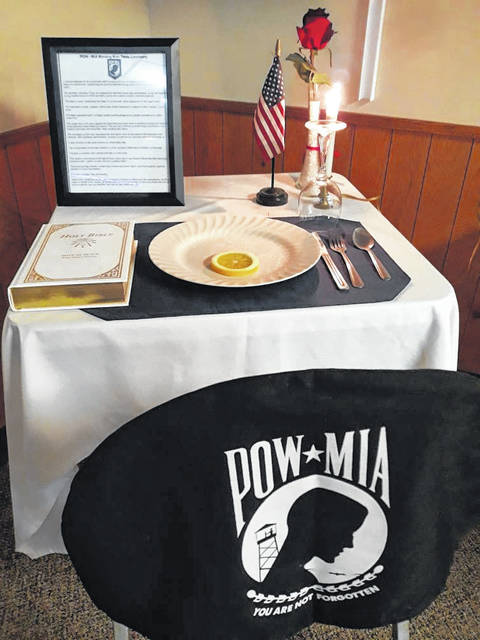
GREENVILLE — September is a month of long beginnings. As Labor Day heralds the conclusion of summertime Americana of fairs, hot-dogs, ice-cream cones and days at the beach, it also beckons the return of restless children to their classrooms, along with an ever-increasing list of school supplies, books, and homework.
Ironically, in this busy flurry, September is also the month in which Americans pause to reflect upon the creation of the U.S. Constitution, the Bill of Rights, and the promises of life, liberty and the pursuit of happiness. On the many battlefields throughout American history, courageous men and women have sacrificed their own lives, fortunes, and sacred honor defending these freedoms.
Many military families face long periods of waiting to know what happened to their loved ones; months turn into years, and years turn into decades. For many, the empty chair at the dinner table, and the somber silence that accompanies it, is a sobering reminder that such freedom isn’t “free.” This “empty place at the table” represents those whose whereabouts are unknown, — the missing in action and the prisoners of war — who have yet to return home.
Today, the “White Table,” also known as the “Missing Man Table,” is one way to honor the importance of POW/MIA Recognition Day. Indeed, Greenville’s Veterans of Foreign Wars (VFW) Post #7262 has a permanent table reserved in the corner 365 days a year to honor POW/MIAs.
The symbolism in each aspect of the place setting speaks volumes — the white tablecloth (representing the purity of motive when answering the call to duty), the small round table (representing everlasting concern for the missing), the single red rose (representing each life missing, and those loved ones who keep the faith, awaiting answers), the vase tied with a red ribbon (representing the continued determination to account for the missing), the slice of lemon on the bread plate (representing the bitter fate of those captured and missing on foreign soil), a pinch of salt (representing the tears endured by the missing and their families who seek answers), the Bible (representing strength gained through faith, as one nation under God), the inverted glass (symbolizing the inability of those missing or lost to share a toast), and the empty chair (the missing and the lost, themselves).
“I’ve done a lot of POW/MIA ceremonies. I’m a lifetime member of the Greenville Memorial Post #7262, and every time I speak on the subject of POW/MIA, I have an inner feeling that tells me I’m not really qualified to talk about it,” says VFW member Don Dietrich, Corporal USMC 3rd Battalion, 3rd Marine Div., Vietnam (1966-1967). “I have the most respect for those missing in action or prisoners of war. I remember when I first arrived in Vietnam as a young marine, I wasn’t so scared of dying, because at that age, we believe we are invincible. But I was mostly concerned of what I would do if I became a POW….”
Dietrich recalls a conversation with a World War II POW, captured in Germany. “He looked at me and said, ‘That POW camp wasn’t like Hogan’s Heroes!’” Indeed, one only needs to read of the horrific experiences of airmen POW survivors from Stalag Luft camps to know the suffering and misery they endured to make it out alive.
In fact, the sheer volume of Americans listed as POW/MIAs is overwhelming. From World War II, the Korean War, Vietnam, the Cold War (military operations), and conflicts since 1991, the Defense POW/MIA Accounting Agency (DPAA) reports that 83,114 Americans who fought in those wars are still missing; 75 percent of those Americans are somewhere in the Asia-Pacific, and more than 41,000 have been presumed lost at sea. In 2018, Vice President Mike Pence received the remains of 55 POW/MIAs upon their return to U.S soil from North Korea; yet, 5,000 soldiers are still considered missing today.
In 1979, after more than 2,500 families of Vietnam War POW/MIAs petitioned Congress, President Jimmy Carter signed a resolution to make the third Friday of every September National POW/MIA Recognition Day, to honor those in military service who have never returned home to American soil.
On every POW/MIA Recognition Day since 1982, the black and white POW/MIA flag, designed by World War II pilot Newt Heisley, depicting the image of a gaunt man symbolizing sorrow, anxiety, and hope, has flown just below the American flag at the White House. Since 1998, it has flown on every national military holiday.
“When I think of POWs and MIAs, I remember that Merle Haggard song from 1972, ‘I Wonder If They Ever Think of Me.’ That song can work in today’s society, too….” said Dietrich.
Today — September 18 — is National POW/MIA Recognition Day. Look up at the beautiful blue September sky. Be thankful. Be kind. Remember to think of them. They might still be thinking of us.





